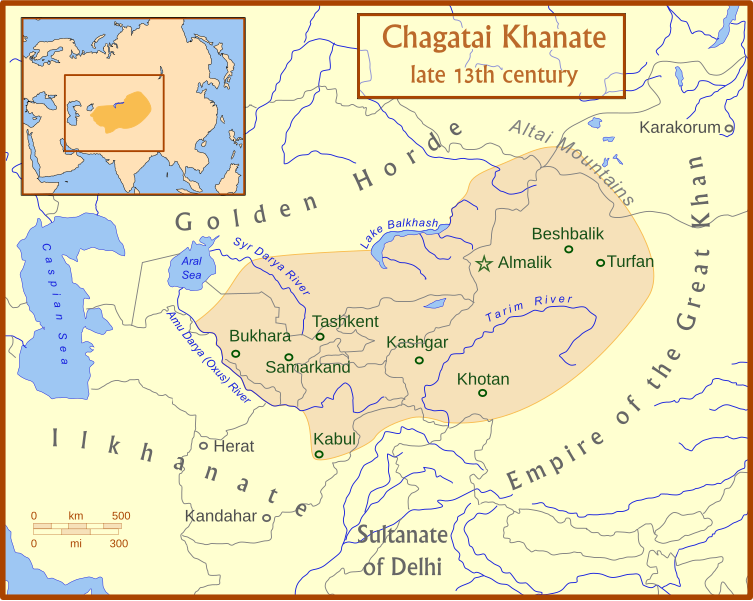The Chagatai Khanate (Mongolian: Tsagadain Khaant Uls/Цагадайн Хаант УлÑ) was a Mongol khanate that comprised the lands ruled by Chagatai Khan, second son of Genghis Khan, and his descendents and successors. Initially it was a part of the Mongol Empire, but it later became fully independent when the Yuan Dynasty fell in the late 14th century. The Chagatai Khans themselves recognized the sovereignty of the Mongolian Khagans between 1206 and 1270 and 1304 and 1368.
At its height in the late 13th century, the Khanate extended from the Amu Darya south of the Aral Sea to the Altai Mountains in the border of modern-day Mongolia and China.
The khanate lasted in one form or another from 1220s until the late 17th century, although the western half of the khanate was lost to Tamerlane in the 1360s. The eastern half remained under Chagatai khans who were, at times, allied or at war with Timur's successors. Finally, in the 17th century, the remaining Chagatai domains fell under the theocratic regime of Apaq Khoja and his descendants, the Khojijans, who ruled Xinjiang under Dzungar and Manchu overlordships consecutively.
Formation

Genghis Khan's empire was inherited by his third son, Ögedei, the designated Great Khan who personally controlled the lands east of Lake Balkash as far as Mongolia. Tolui, the youngest, the keeper of the hearth, was accorded the northern Mongolian homeland. Chagatai, the second son, received Transoxania, between the Amu Darya and Syr Darya rivers in modern Uzbekistan, and the area around Kashgar. He made his capital at Almaliq near what is now Yining in northwestern China. Apart from problems of lineage and inheritance, the Mongol Empire was endangered by the great cultural and ethnic divide between the Mongols themselves and their mostly Islamic Turkic subjects.
When Ögedei died before achieving his dream of conquering all of China, there was an unsettled transition to his son Güyük (1241) overseen by Ögedei's wife Töregene who had assumed the regency for the five years following Ögedei's death. The transition had to be ratified in a kurultai, which was duly celebrated, but without the presence of Batu, the independent-minded khan of the Golden Horde. After Güyük's death, Batu sent Berke, who maneuvered with Tolui's widow, and, in the next kurultai (1253), the Ögedite line was passed over for Möngke, Tolui's son, who was said to be favorable to Nestorian Christianity. The Ögedite ulus was dismembered; only the Ögedites who did not immediately go into opposition were given minor fiefs.
The Chagatai Khanate after Chagatai
.png/800px-Chagatai_Khanate_(1490).png)
Chagatai died in 1242, shortly after his brother Ögedei. For nearly twenty years after this the Chagatai Khanate was little more than a dependency of the Mongol central government, which deposed and appointed khans as it pleased. The cities of Transoxiana, while located within the boundaries of the khanate, were administrated by officials who answered directly to the Great Khan.
This state of subservience to the central government was ended during the reign of Chagatai's grandson Alghu (1260â€"1266), who took advantage of the Toluid Civil War between Khubilai and Ariq Boke by revolting against the latter, seizing new territories and gaining the allegiance of the Great Khan's authorities in Transoxiana. Most of the Chagatayids first supported Khubilai but in 1269 they joined forces with the House of Ogedei.
Alghu's eventual successor, Baraq (1266â€"1271), who expelled the Khubilai Khan's governor in Sinkiang soon came into conflict with the Ögedite Kaidu (Qaidu), who gained the support of the Golden Horde and attacked the Chagatayids.
Baraq was soon confined to Transoxiana and forced to become a vassal of Kaidu. At the same time, he was at odds with Abaqa, the Ilkhan, who ruled his Ilkhanate in Persia. Baraq attacked first, but was defeated by the Ilkhanate army and forced to return to Transoxiana, where he died not long after.
The next several Chagatayid khans were appointed by Kaidu, who maintained a hold upon the khanate until his death. He finally found a suitable khan in Baraq's son Duwa (1282â€"1307), who participated in Kaidu's wars with Khubilai khan and his successors of the Yuan Dynasty. The two rulers also were active against the Ilkhanate. After Kaidu's death in 1301, Duwa threw off his allegiance to his successor. He also made peace with the Yuan Dynasty and paid tributes to the Yuan court; by the time of his death the Chagatai Khanate was a virtually independent state.
Fall

Duwa left behind numerous sons, many of whom became khans themselves. Included among these are Kebek (1309, 1318â€"1326), who instituted a standardization of the coinage and selected a sedentary capital (at Qarshi), and Tarmashirin (1326â€"1334), who converted to Islam and raided the Sultanate of Delhi in India. The center of the khanate was shifting to its western regions, i.e. Transoxiana.
The Chagatai Khanate split into two parts in the 1340s and completely fell. It is debatable whether the Western Chagatai Khanate in Transoxiana and Moghulistan (Eastern Chagatai Khanate) were a continuation of the Chagatai Khanate. In the west (Transoxiana), the mostly Muslim Mongol tribes, led by the Qara'unas amirs, seized control. In order to maintain a link to the house of Genghis Khan, the amirs set several of his descendants on the throne, though these khans ruled in name only and had no real power. The eastern part of the khanate, meanwhile, had been largely autonomous for several years as a result of the khans' weakening power. This eastern portion (most of which was known as "Moghulistan") was, in contrast to Transoxiana, primarily inhabited by Mongols and was largely Buddhist and Shamanist.
Tarmashirin, however, was brought down by a rebellion of the tribes in the eastern provinces and the khanate became increasingly unstable in the following years. In 1346 a tribal chief, Qazaghan, killed the Chagatai khan Qazan during a revolt.
The last independent Chagatai Khanate, the Yarkent Khanate, was conquered by the Dzungar Khanate in the Dzungar conquest of Altishahr from 1678-1680.
List of rulers

- List of Chagatai khans

